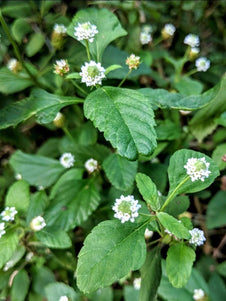





Aztec Sweet Herb
Aztec Sweet Herb

- Low stock - 15 items left
- Inventory on the way

Usually available: All year
Life cycle: Perennial
Height: 50cm
Position: Sun / part shade
Soil preference: Well drained
This is how we pack and send your Herb Plants to all states except TAS & WA
You will receive
- 1 Aztec Sweet Herb Herb Plant in a 50 X 75mm tube - General growing instructions
All of our Herb Plants are grown organically with certified organic potting mixes and fertilizers
Botanical Name: Phyla scaberrima
Aztec Sweet Herb is a low growing creeping and trailing perennial reaching 50cm high and with a 50cm to 1 meter spread. The 2.5 cm dark green leaves are toothed with clear veins and are held in opposite pairs. The egg shaped leaves may turn brown-purple in bright sun and have a dark crimson stem. The tiny white flowers are held in a 6mm circular cluster which has a centre, formed by tiny green bracts peeling away to reveal new flowers of barely 1.6 mm in size.
Aztec Sweet Herb is from the Verbenaceae family and may also be known by the common names Mexican Lipia, Bushy Lippia and Honey Herb. Lippia dulcis is the most often used botanical name and Yerba dulce less commonly. However the most recent taxonomic reclassification of this plant is to Phyla scaberrima. The Greek word for tribe is ‘phyla’ referring to the cluster of flower heads and ‘scaberimma’ is Latin for ‘most rough’. It is native to Central America, Southern Mexico, Colombia and the Caribbean.
This plant was used as a culinary and medicinal herb by indigenous tribes and the Aztecs and was later introduced to the Spanish. It has a history of use as a sweetener in Central America, with use recorded as far back as 1570. The chemicals responsible for the sweet taste are sequiterpene compounds called hernandulcin. They were discovered in 1985 and named after Francisco Hernandez, the Spanish explorer who first described the plant in the 16th century. Although hernandulcin is not considered harmful, the camphor content of the leaves is toxic in sufficient quantities.
Aztec Sweet Herb is most often grown today as an ornamental, with the occasional exploration as a home sweetener for herbal tea.
Growing Conditions
Aztec Sweet Herb requires several hours of sunshine per day, but can grow well in part shade and most soil types with adequate moisture. Once established it does not have high water requirements. Temperate to sub-tropical regions provide an ideal climate for this evergreen perennial. It is heat tolerant but may not do well in frost prone areas and may die back in cold winters. This creeping plant may be propagated by seed, but best results are achieved by layering because where the branches touch the ground they will form roots.
Although from a different plant family, this plant is much like mint in looks and character, so it should be kept contained to prevent undesired spreading. This small creeper is an ideal plant for hanging baskets where it is able to trail over the edges. This also allows clean leaves to be easily collected as used as desired.
Culinary Uses
Aztec Sweet Herb was used traditionally as a natural sweetener by Aztecs and indigenous people in Central America countries from at least 1570. It is up to 1500 times sweeter than sugar, but should be used sparingly. The sweet taste is accompanied by the camphor content, which has a bitter taste and is toxic to the nervous system especially for children and small animals. It may cause nausea, vomiting, coma and depression of the central nervous system.
The toxicity of Aztec Sweet Herb means that its use as a sugar replacement, or as an alternative to Stevia, is not viable in the average modern diet or on a commercial level. The amount consumed daily would be far above recommended dosages and the active constituents may be carcinogenic in large quantities.
Leaves are picked and used fresh or dried as needed as a sweetener in herbal teas. Some people have likened it to tasting a sweet camphor moth ball. It is not recommended for children or pregnant women due to the potential antispasmodic effects.
Medicinal Uses
Aztec Sweet Herb has historical significance as a medicinal herb for the Aztecs, tribal cultures in Central American countries and later the Spanish were introduced to the plant. It has a soothing and calming effect on mucosal surfaces and today may be used by some herbalists as an expectorant for coughs, bronchitis and respiratory ailments. The plant is boiled and the vapours inhaled by placing the head over the bowl. Afterwards, the infusion is strained and sipped slowly. For toothaches the plant may be chewed or placed directly on the gums. This herb has many other traditional or folk uses which were first applied by the Aztecs and Central American indigenous people. These included use for indigestion, liver disorders, dysentery, hypertension, and to induce miscarriage with its spasmodic effects.
Modern medical research has started preliminary investigations into the usefulness of the plant as an anti-microbial and anti-inflammatory agent. However it should be noted that the active constituents have shown carcinogenic activity and camphor is toxic in sufficient doses.
All information provided on this website is for informational purposes only. Please seek professional advice before commencing any treatment.






